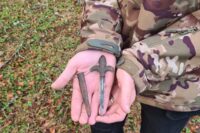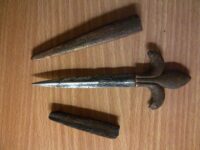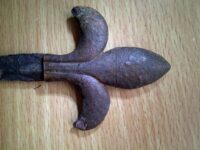 A metal detectorist has discovered an unusual medieval knife in the woods near Penicuik, Midlothian, Scotland. Craig Johnstone theorized that survivors of the Battle of Rullion Green in 1666 had escaped through Deanburn woods and was hoping to find archaeological evidence of it when he came across the much earlier and more precious object. The knife was caked in mud so it looked like a tapered piece of metal topped with a fleur-de-lis. Johnstone thought it might be the top of an iron railing that had broken off.
A metal detectorist has discovered an unusual medieval knife in the woods near Penicuik, Midlothian, Scotland. Craig Johnstone theorized that survivors of the Battle of Rullion Green in 1666 had escaped through Deanburn woods and was hoping to find archaeological evidence of it when he came across the much earlier and more precious object. The knife was caked in mud so it looked like a tapered piece of metal topped with a fleur-de-lis. Johnstone thought it might be the top of an iron railing that had broken off.
A friend on the Midlothian council showed it to the council archaeologist and she recognized it as a knife. She recommended (and this sounds a little crazy to me) that they heat it up in an oven at a low temperature with the door open. The heated blade pulled easily out of the sheath along with two pieces of leather that protected the knife from wear in the scabbard.
 With a blade only three inches long, the knife is a Skean-Dhu, meaning black or hidden knife in Gaelic. They were concealed carry weapons for noblemen, basically, so small they could be easily hidden in sleeves and waistbands. It is a high-quality blade with a hollow grind (a very sharp beveled cutting edge like a straight razor). The fleur-de-lis handle is bronze which may have originally been gilded.
With a blade only three inches long, the knife is a Skean-Dhu, meaning black or hidden knife in Gaelic. They were concealed carry weapons for noblemen, basically, so small they could be easily hidden in sleeves and waistbands. It is a high-quality blade with a hollow grind (a very sharp beveled cutting edge like a straight razor). The fleur-de-lis handle is bronze which may have originally been gilded.
The first expert to examine the knife thought it dated to the 16th century. Johnstone reported it to local Treasure Trove authorities who at first dismissed it as “relatively modern.” Only after Johnstone had the object radiocarbon dated at his own expense did he get evidence that it was far older than anybody had yet realized. The leather dates to between 1191 and 1273. Armed with this new data, he informed Treasure Trove that his knife was, in fact, relatively medieval and it will now be assessed by the Scottish Archaeological Finds Allocation Panel.
A Treasure Trove spokeswoman said: “This is a highly unusual object, comprising of a blade with a hilt and a metal scabbard with leather inside. While the leather and blade date from the medieval period, the hilt and scabbard are unusual for the period.
“Treasure Trove are still carrying out investigations into the object. It was due to be x-rayed as part of the investigation process, but this has unfortunately been delayed due to Covid-19 restrictions.”
 I’m guessing the fleur-de-lis handle was a later modification. Scotland’s association with the fleur-de-lis goes back to its alliance with France against England in the Hundred Years’ War. When this blade was crafted at the end of the 12th or early 13th century, the French monarchy had only begun to use the fleur-de-lis as a symbol of divine right rule. It wasn’t even on the Arms of France until the 1220s, although it does make an appearance on the seal of the future king Louis VIII in 1211.
I’m guessing the fleur-de-lis handle was a later modification. Scotland’s association with the fleur-de-lis goes back to its alliance with France against England in the Hundred Years’ War. When this blade was crafted at the end of the 12th or early 13th century, the French monarchy had only begun to use the fleur-de-lis as a symbol of divine right rule. It wasn’t even on the Arms of France until the 1220s, although it does make an appearance on the seal of the future king Louis VIII in 1211.
Something in the train of logic is not adding up. Yes, you could take an old knife and put a new handle on it, but then why would you keep the old scabbard with its old leather interior, while going as far as matching the new handle to the old scabbard?
It seems to me much more likely that either this is the knife as it was manufactured or an old blade with newer scabbard/handle/leather combination.
I would say that someone was in France in 12-something and bought the latest toy – a fleur-de-lis knife. I remember buying a flick knife with 3 inch blade when I was in Germany in the 1970s to take back home and impress my friends.
Penicuik seems to have been the site of a prison camp for French prisoners during the Napoleonic Wars. Maybe a paper knife could have been some sort of talisman in battle. Maybe it was ‘improvised’.
Likewise, in 1666 someone might have carried a –by then 300 year old– “Skean-Dhu” in his (or hers) waistbands, and this is what it might have looked like (note the loose dagger in his bands):
——
upload.wikimedia.org/wikipedia/commons/5/55/Don_Juan_d’Austria_1.JPG
——
“John of Austria” (b. 1547), the illegitimate son of Emperor Charles V and Barbara Blomberg (Plumberger), a 19 year old burgher’s daughter that Charles met in Regensburg in Bavaria, became a military leader in the service of his half-brother, King Philip II of Spain, and is best known as admiral at the naval Battle of Lepanto against the Turks. With reference to yesterday’s post, in the northern Low Countries they allegedly wanted to be in the 16th century ‘Liever Turks dan Paaps’ / rather ‘be Turkish than papist’ 😆
Trevor and friends,
The story found in most books on Scottish arms has been that the skene dub (“black knife”, from the bog oak used for the grips) was an 18th C. invention for kilted troops in the English army. These knives were intended as eating utensils, and were sometimes part of a set that included a spoon and fork. This evolved into the modern decorative sock knife we all associate with Scotsmen.
There is no reason Scots could not have had small concealed knives far earlier, and this find could change what we know about how Scots armed themselves.
Dating old Scottish steel can be a bit dicey. Broadswords, including the famous 15th C. two-handers somewhat incorrectly called “claymores” (that term came later for the 17th C. basket-hilt military sword) were too valuable to scrap. As weaponry changed, old steel was repurposed by the rather penurious Scots. Many broadswords were cut down into dirks as fighting styles changed. Two-handers also were shortened, given basket hilts, and continued to be used for many years. Thus an 18th or 19th century sword blade might test as something far older.
That is not to say that this small knife is inauthentic, and we may learn something new from study of it.
The close Scottish association with France dates to a 1295 mutual mutual defense pact against England. Edward I, who had set John Balliol on the Scottish throne as his puppet, was furious. Balliol was sacked, humiliated and placed under house arrest. Edward then declared Scotland his to rule. Thus we get William Wallace and all that Braveheart stuff. The French pact was renewed several times until the 1500s, and was generally called the “Alud Alliance” (Old Alliance) by the Scots.
Not central to this discussion, but as a re-enactor who portrays a late 15th C. Lowland Scot, I do carry a skene dub in my boot. I have always felt that it was not truly period for my character, but it is what others expect to see on a Scot. Who am I to disappoint them?
Yours Aye,
Lord Mungo Napier, Laird of Mallard Lodge (SCA)
(aka Garth Groff)
Thanks, Garth. Personally, I was not aware of the association with France of 1295 as a mutual defense pact, but there also is an attempted trade agreement.
In October 1297, after the ‘Battle of Stirling Bridge’ and before the ‘Battle of Falkirk’ in April 1298, the “duces” Andy Murray and ‘Braveheart’ sent a letter –written in Latin– to Lübeck (who still keep it in their city archives).
If that 1297 trade agreement was at least partially successful, I am unable to tell.
As Mr. Braveheart put it, “Vale(te)” :hattip:
————
“Andreas de morauia et Wilhelmus Wallensis, duces exercitus Regni Scotie, et communitas ejusdem Regni, providis viris et discretis ac amicis dilectis, Majoribus et communis de Lubek et de Hamburg salutem et sincere dilectionis semper incrementum. […]
“Andrew de Murray and William Wallace, leaders of the army of the kingdom of Scotland, and the community of the same kingdom, to their worthy, discreet and beloved friends the mayors and communes of Lübeck and Hamburg, greeting, and increase always of sincere friendship. It has been intimated to us by trustworthy merchants of the said kingdom of Scotland that you by your own goodwill are giving counsel, help and favour in all causes and business concerning us and our merchants, although our merits had not deserved this, and therefore all the more are we bound to you to give you thanks and a worthy recompense, to do which we are willing to be obliged to you; and we ask you that you will make it be proclaimed amongst your merchants that they can have secure access to all ports of the kingdom of Scotland with their merchandise since the kingdom of Scotland, thanks be to God, has by arms been recovered from the power of the English. Farewell. Given at Haddington in Scotland on the 11th day of October in the year of grace one thousand two hundred and ninety seven. We request moreover that you will see fit to forward the business of John Burnet and John Frere, our merchants, just as you wish us to forward the business of your merchants. Farewell. Given as before.”
————
Hi all
I am the finder and all very interesting comments, The scabbard cannot be ignored either with designs of medeivil swords on both sides with filigrae pattern to take the silve leaf for the blade the surrounding are was covered in gold leaf. very inrticate for a small knife. and why the hollow ground blade according to experts to a very high standard.
I have had a real battle with supposed experts who initially dismissed this knife a a relatively modern item.
so after i got it carbon dated i then presented this evidence and the 2nd report is not much better than the 1st one… but i am getting this resolved by the help of a local swordsmith and arms expert.
I personally think it may be a relic from the Battle of Roslin or possibly a templar connection. I may never find out so any leads or suggestins please let me know at johnstone518@btinternet.com
Regards
Craig Johnstone
Hi all
I am the finder of this knife and appreciate all your comments.
I have focused on the scabbard lately for clues as it has 2 designs of medeivil swords on it with traces of gold and silver leaf.
It may have been from the Battle of Roslin or a Templar as the fleur de lis was also a templar symbol
johnstone518@btinternet.com
Regards
Craig
Hi all
I am the finder of this knife and appreciate all your comments.
I have focused on the scabbard lately for clues as it has 2 designs of medeivil swords on it with traces of gold and silver leaf.
It may have been from the Battle of Roslin or a Templar as the fleur de lis was also a templar symbol
Regards
Craig, whatever the story behind it might actually be, yours is definitely a cool find.
I am unsure of, what exactly you mean by ‘2 designs of medieval swords on it‘, but one of those designs might be the form of the blade. Traces of gold (plating) may be, what is to be seen at the stem of the handle. If the fleur-de-lis handle was a later modification or not, my guess would be that somebody wore it in his boots, or with Garth, in his socks.
A usefulness in real combat, or at least assassination attempts, would have been rather limited, I assume (in combination with a club, it might have worked, though). I am no expert, but on an ancient battlefield site there would be a considerable amount of metal to be detected, I reckon.
–Thanks and Greetings, Vale :hattip:
What a great find! I am far from an expert on blades, but this looks to me like a push or punch dagger. It looks like it was designed to hold with two fingers on each side of the blade and the top of the fleur-de-lis in the palm. Even if the hilt is a more recent replacement, the shape of the blade looks designed for stabbing rather than slashing with a fine point and strong spine.
the scabbard has a design of swords on each side
craig
Craig,
Your suggestion about the 1303 Battle of Roslin is interesting. How close is the find site to Roslin village?
Reliable knowledge of this battle is pretty sketchy, and some commentators have blown it up to a major fight and a monumental Scottish victory. But if this knife does come from the Battle of Roslin, it is as likely to be English as Scottish.
There were apparently two small battles fought that day, possibly three. So lost weapons and possessions from either side could be scattered over a fairly large area.
The fleur de lis grip is what confuses me the most, especially for a Roslin connection. The official relationship between the Scots and France was just beginning, so French influence would be slim. However, both Scottish and English lords of Norman descent still held lands in the parts of France occupied by England. There were also trade links from both countries to France.
Thanks for finding this rare and interesting weapon. I hope scholarly analysis is able to fit into its proper place in history.
Yours Aye,
Mungo Napier, Laird of Mallard Lodge (SCA) 🦆
It would be interesting to know, where the steel in the blade does originate from.
Folks who took part in the ‘First War of Scottish Independence’ had earlier taken part in the ‘Anglo-French War of 1294–1303’, e.g. people like Aymer de Valence, 2nd Earl of Pembroke, who is buried in Westminster Abbey, or Simon Fraser, who was emasculated, eviscerated and finally quartered nearby in Smithfield :no:
—————
PS: Already in 1814, that special sort of punishment was replaced by a full hanging, i.e. with the quartering bit done posthumous, until with the ‘Forfeiture Act of 1870’ the hanging, drawing and quartering was in England replaced by ‘Transportation to the Colonies’, which by now is life imprisonment.
There must currently be something wrong with those colonies, I suppose.
Chelsea,
Good point on the steel origins. Scotland was deficient in iron and steel until the industrial revolution, so the blade will almost certainly be from somewhere else.
The Scots imported what iron and steel they could afford from the Continent, particularly from the German states (often through Scottish trade depots in Hanseatic League cities). The famous two-handed Scottish swords which appeared in the early 15th C. were mostly made from German blanks that were finished and hilted in Scotland.
As an aside, there were two styles of the Scottish two-handers. The better-known pattern had cross guards / quillions which angled downward toward the blade’s point. See examples at https://en.wikipedia.org/wiki/Claymore . Lowland two-handed swords commonly had quillions that extended at right angles from the hilt.
Yours Aye,
Lord Mungo Napier, Laird of Mallard Lodge (SCA) 🦆
(aka Garth Groff)
It is approx 3 miles from one of the battle sites from Roslyn.
The hilt is definitely more symbolic than usefull. Or deliberately made not to look like a knife.
I have been researching this for 5 years now and trying to get the supposed experts to recognise this knife for its age.
Thanks for all the inputs
Craig
It is approx 3 miles from one of the battle sites from Roslyn.
The hilt is definitely more symbolic than usefull. Or deliberately made not to look like a knife.
I have been researching this for 5 years now and trying to get the supposed experts to recognise this knife for its age.
Thanks for all the inputs :boogie: :thanks:
Craig
Is there anyway of telling where the metal would have come from blade or hilt.
Craig